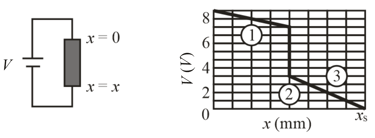Resnick & Halliday Solutions for Chapter: Current and Resistance, Exercise 1: Problems
Resnick & Halliday Physics Solutions for Exercise - Resnick & Halliday Solutions for Chapter: Current and Resistance, Exercise 1: Problems
Attempt the practice questions on Chapter 26: Current and Resistance, Exercise 1: Problems with hints and solutions to strengthen your understanding. Principles Of Physics International Student Version solutions are prepared by Experienced Embibe Experts.
Questions from Resnick & Halliday Solutions for Chapter: Current and Resistance, Exercise 1: Problems with Hints & Solutions
The magnitude of the current density in a certain cylindrical wire is given as a function of radial distance from the centre of the wire's cross-section as where, is in meters, is in amperes per square meter, and This function applies out to the wire's radius of . How much current is contained within the width of a thin ring concentric with the wire if the ring has a radial width of and is at a radial distance of
A wire long and in diameter has a resistance of A potential difference of is applied between the ends. (a) What is the current in the wire? (b) What is the magnitude of the current density? (c) Calculate the resistivity of the wire material. (d) Using Table, identify the material.
| Material | Resistivity (in ) |
| Silver | |
| Copper | |
| Aluminium | |
| Iron | |
| Platinum | |
| Manganin |
An electrical cable consists of strands of fine wire, each having resistance. The same potential difference is applied between the ends of all the strands and results in a total current of .(a) What is the current in each strand? (b) What is the applied potential difference? (c) What is the resistance of the cable?
In Fig.(a), a battery is connected to a resistive strip that consists of three sections with the same cross-sectional areas but different conductivities. Figure (b) gives the electric potential versus position along the strip. The horizontal scale is set by Section has conductivity . What is the conductivity of section (a) and (b)

(a) (b)
In Fig. current is set up through a truncated right circular cone of resistivity whose left radius is , right radius is and length Assume that the current density is uniform across any cross section taken perpendicular to the length. What is the resistance of the cone?

An isolated conducting sphere has a radius. One wire carries a current of into it. Another wire carries a current of out of it. How long would it take for the sphere to increase in potential by
A beam contains doubly charged negative ions per cubic centimeter, all of which are moving north with a speed of . What are the (a) magnitude (b) direction of the current density (c) If the particle distribution is uniform across a cross-sectional area of what is the current?
The magnitude of the current density in a certain lab wire with a circular cross section of radius is given by with in amperes per square meter and radial distance in meters. What is the current through the outer section bounded by and ?
